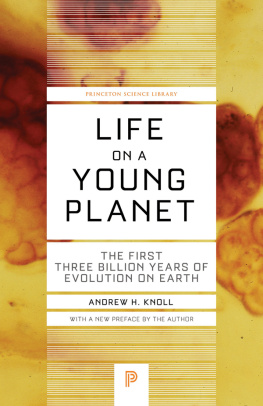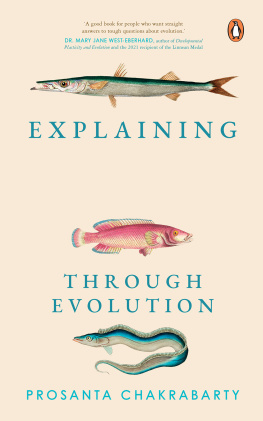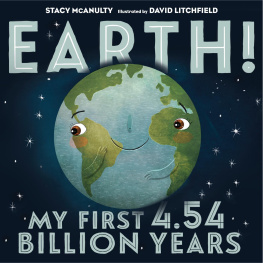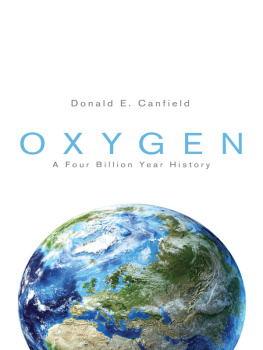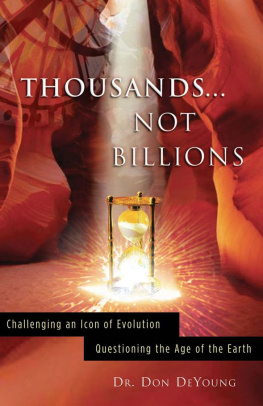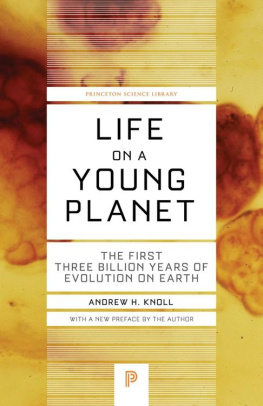Knoll - Life on a young planet: the first three billion years of evolution on earth
Here you can read online Knoll - Life on a young planet: the first three billion years of evolution on earth full text of the book (entire story) in english for free. Download pdf and epub, get meaning, cover and reviews about this ebook. City: Princeton, year: 2015, publisher: Princeton University Press, genre: Romance novel. Description of the work, (preface) as well as reviews are available. Best literature library LitArk.com created for fans of good reading and offers a wide selection of genres:
Romance novel
Science fiction
Adventure
Detective
Science
History
Home and family
Prose
Art
Politics
Computer
Non-fiction
Religion
Business
Children
Humor
Choose a favorite category and find really read worthwhile books. Enjoy immersion in the world of imagination, feel the emotions of the characters or learn something new for yourself, make an fascinating discovery.
- Book:Life on a young planet: the first three billion years of evolution on earth
- Author:
- Publisher:Princeton University Press
- Genre:
- Year:2015
- City:Princeton
- Rating:3 / 5
- Favourites:Add to favourites
- Your mark:
- 60
- 1
- 2
- 3
- 4
- 5
Life on a young planet: the first three billion years of evolution on earth: summary, description and annotation
We offer to read an annotation, description, summary or preface (depends on what the author of the book "Life on a young planet: the first three billion years of evolution on earth" wrote himself). If you haven't found the necessary information about the book — write in the comments, we will try to find it.
Knoll: author's other books
Who wrote Life on a young planet: the first three billion years of evolution on earth? Find out the surname, the name of the author of the book and a list of all author's works by series.
Life on a young planet: the first three billion years of evolution on earth — read online for free the complete book (whole text) full work
Below is the text of the book, divided by pages. System saving the place of the last page read, allows you to conveniently read the book "Life on a young planet: the first three billion years of evolution on earth" online for free, without having to search again every time where you left off. Put a bookmark, and you can go to the page where you finished reading at any time.
Font size:
Interval:
Bookmark:

Life on a Young Planet
Life on a Young Planet | THE FIRST THREE BILLION YEARS OF EVOLUTION ON EARTH |
Andrew H. Knoll
with a new preface by the author
PRINCETON UNIVERSITY PRESS
PRINCETON AND OXFORD
Copyright 2003 by Princeton University Press
Published by Princeton University Press, 41 William Street, Princeton, New Jersey 08540
In the United Kingdom: Princeton University Press, 6 Oxford Street, Woodstock, Oxfordshire OX20 1TW
First Princeton Science Library printing, 2005
New Princeton Science Library paperback edition, with a new preface by the author, 2015
Paperback ISBN 978-0-691-16553-0
Library of Congress Control Number 2014955273
British Library Cataloging-in-Publication Data is available
This book has been composed in Palatino
Printed on acid-free paper.
press.princeton.edu
Printed in the United States of America
1 3 5 7 9 10 8 6 4 2
For my parents.
In nature and in nurture,
I was lucky.
Acknowledgments
T HIS VOLUME distills the thoughts of a quarter century spent trying to understand the early history of life. I first entertained the idea of writing a book more than a decade ago, but fortunately got sidetracked. Children, research, and university responsibilities kept me from reconsidering such a plunge until the fall of 1998, when the alignment of growing kids, the end of my term as department chair, and a sabbatical leave convinced me that the time was right to attempt what for me was a new style of scholarship. Of course, my children werent the only ones who had matured in the interim, and so whatever critical fate awaits this volume, I can honestly state that it is far better than it would have been had I completed it at first consideration.
For all the caricatures of scientists as creative loners, science is a richly social endeavor. Our worldviews evolve by reading the works of those who went before, by teaching and learning, through collaboration, conversation, and argument. The ideas and experiences related in the following pages owe much to others, many of them mentioned in one chapter or another. Elso Barghoorn guided my thesis research, providing me with opportunities, support, and a collegiality whose obvious asymmetry he never stressed. My graduate education was shaped as well by Ray Siever, Dick Holland, Steve Golubic, and the late Steve Gould and Bernie Kummel, all of whom seemed to spot in me a potential I would never have seen for myself.
The students and postdoctoral fellows in my lab have been a continuing source of joy and intellectual sustenance, and I thank them all. I have also benefited enormously from wonderful colleagues. My friends in biology and the Earth sciences at Harvard keep me ever on my toes.
In the world beyond Harvard Yard, I am particularly grateful for the friendship and intellectual stimulation of John Grotzinger, Sam Bowring, John Hayes, Malcolm Walter, Roger Summons, Keene Swett, Yin Leiming, Misha Semikhatov, Misha Fedonkin, Volodya Sergeev, Gerard Germs, Stefan Bengtson, Simon Conway Morris, Brian Harland, Don Canfield, Ariel Anbar, Dave Des Marais, Ken Nealson, Sean Carroll, and my departed friends Zhang Yun, Gonzalo Vidal, and Preston Cloud.
Of course, books are not written in the office or in the field. They get finished in the upstairs study, on weeknights after the homework is done. Book writing, therefore, is very much a family affair. In a profession that commonly rewards obsession, my children have given me the gift of balance in life. And even by confessing that I lack words to articulate my gratitude, I risk trivializing the importance of my wife Marsha.
Much of my research over the years has been funded by the National Science Foundation and NASA, including the NASA Astrobiology Institute. I am grateful for their support. I also thank Dick Bambach, Susannah Porter, Don Canfield, Sean Carroll, Jack Repcheck, Kristen Gager, Lawrence Krauss, and Marsha Knoll for reading my draft manuscript and making many suggestions for improvement. John Bauld, Roger Buick, Stefan Bengtson, Martin Brasier, Birger Rasmussen, Shuhai Xiao, Richard Jenkins, Leonid Popov, Dave Bottjer, Steve Dornbos, Greg Wray, Andreas Teske, Susannah Porter, Bruce Lieberman, and Nick Butterfield provided some of the illustrations that leaven my text. Lastly, I thank Sam Elworthy and Princeton University Press for their unstinting support and confidence. Sam has been my Maxwell Perkins, improving every page of what follows.
Preface to the New Paperback Edition
F OURTEEN YEARS AGO , amid millennial predictions of global computer failure and other apocalypses that never transpired, I decided it was time to explain myself. For more than two decades, I had been preoccupied with the attempt to understand an unfamiliar planetone without plants or animals, and with little or no oxygen in the atmosphere. That planet was the young Earth, and how our globe transited from that early, alien state to the world we know today struck me (and still does) as the greatest story Earth science has to tell. In part the quest was paleontological, requiring the meticulous examination of ancient rocks in search of fossilized microbes. In part it was phylogenetic, using the information recorded in genes to sketch out the tree of life, a universal genealogy that makes predictions for lifes geologic record. And in part, the task was geochemical, using the chemistry of ancient rocks to reconstruct Earths environmental past. Could we develop a narrative of lifes deep history that stretches from the origin of life to the spread of animals throughout the oceans more than three billion years later? Could we construct a parallel account of environmental history that traces the rise of atmospheric oxygen and episodic ice ages of global extent? And, most importantly, could we combine our narratives of life and environment to understand how organisms and their surroundings have co-evolved through time? The result was Life on a Young Planet, first published in 2003. The decision to reissue this work in a new format affords an opportunity to revisit my earlier effort and consider how the field has progressed over the past decade.
Standing back, the big picture remains much the same: a limited and challenging record of the Archean (> 2.5 billion years ago) Earth that nonetheless documents microbial ecosystems in a world with little or no O2; a long middle age populated by protists as well as prokaryotes, building diversity and cellular complexity beneath an atmosphere with some but not much oxygen; and a dramatic shift in life and environment around 600 million years ago, ushering in our (broadly) familiar world of large animals and abundant oxygen. And the field vignettes still ring true, hopefully providing readers with a sense of how Earth scientists work and not simply a catalog of facts.
That said, many people around the world have made important contributions to this story since I first told my version. For example, while it still makes sense to divide lifes history into three great chapters mediated by oxygen, the details of that environmental history have become far more nuanced, and new debates have emerged. We still think that the Archean atmosphere had, at best, minute traces of oxygen, but several lines of evidence now suggest that more substantial O2 accumulations began to form at least intermittently within the oceans much earlier. The subtle and still debated record of Earths early whiff of oxygen predates the Great Oxygenation Event 2.4 billion years ago by as much as several hundred million years. Increasing evidence also suggests that when oxygen began to accumulate in the atmosphere and surface ocean, it rose to relatively high levels before declining again by two billion years ago.
Next pageFont size:
Interval:
Bookmark:
Similar books «Life on a young planet: the first three billion years of evolution on earth»
Look at similar books to Life on a young planet: the first three billion years of evolution on earth. We have selected literature similar in name and meaning in the hope of providing readers with more options to find new, interesting, not yet read works.
Discussion, reviews of the book Life on a young planet: the first three billion years of evolution on earth and just readers' own opinions. Leave your comments, write what you think about the work, its meaning or the main characters. Specify what exactly you liked and what you didn't like, and why you think so.

